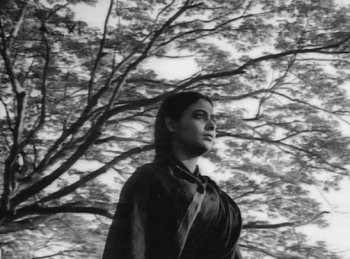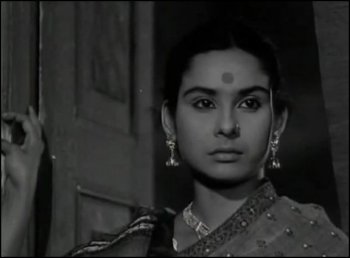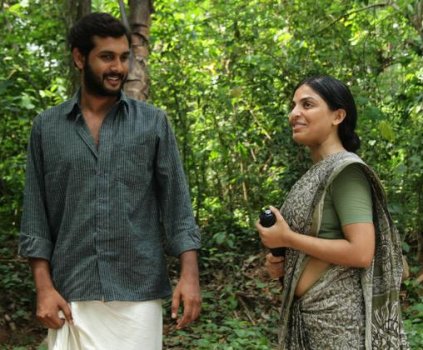
|   |

|   |
Resistance through an art form - Dr. S D Desai e-mail: sureshmrudula@yahoo.co.in January 22, 2014 The four-day Film Fest with the focus on ‘Cinema of Resistance’ at Natarani with judiciously selected films (Courtesy Yadavan Chandran and Mallika Sarabhai) proved as much stimulating intellectually as satisfying to the finer sensibility. Not that the socio-political dimension is insignificant, the festival brought to the fore other more subtle dimensions of the concept of resistance - resistance to inextricable collective social conformism, to radically fresh thinking on life, to built-in individual inhibitions, social resistance to attempting a u-turn even on noticing disaster further ahead.  Meghe Dhaka Tara Ritwik Ghatak’s Meghe Dhaka Tara, a multi-dimensional beauty as a film, in the context of the focus of the festival prompts one to question its central character Neeta’s (Supriya Choudhary) ‘sacrifice’ of her individuality and potential evolution for her selfish and opportunistic members of the family. How would an educated modern woman alive to her own rights and freedom look at it? Her brother, whom she has helped realize his dream of becoming a singer of repute, redeems the family and society pretty late.  Subarnarekha In another gem of a Ghatak film Subarnarekha, the conformist elder brother (Abhi Bhattacharya) of the precocious heroine (Madhabi Mukerjee, later Satyajit’s Charulata), who has expressed her pleasure in acting as his mother, fails to behave as an enlightened elder capable of rising above society’s set norms and consenting to her marrying the young man of her choice belonging to a ‘lower’ caste. Not infallible, he succumbs to unwelcome western influence and is led to a situation of tragic consequences for both. The much-acclaimed recent film Ship of Theseus, in its young director Anand Gandhi’s words, has at its core resistance of status quo. Its three stories – of a beautiful and skilful blind photographer (Aida, an Egyptian photographer) who needs cornea transplant, a monk (Neeraj) who has led a campaign against animal cruelty needs a liver transplant, and a young stockbroker (Soham) who has had a kidney transplanted discovers a kidney transplant racket - have an undercurrent of paradoxes in common which are difficult to resolve. T. V. Chandran’s The Inheritors of the Earth, the third film of his trilogy on Gujarat riots (2002) goes beyond political resistance, its avowed objective, and with its luxuriant visual and aural images of Kerala’s flora, animals and insects, and develops the antithesis to the excesses of human behaviour against shared harmonious living, which is the basis of universal existence. The film’s leitmotif finds culmination in the hero in disgust throwing away title deeds of the blessed land and on its pages lying scattered on the earth its inhabitants crawl, in abandon as it were, to an electrifying effect on the viewers. These films, those I could see, were all outstanding in terms of their craft and content. With what power Ghatak could get portrayed in black and white interspersed with long silences events from the most intimate feeling to the most devastating! Despite recourse to melodrama at times, he comes close to Satyajit Ray in capturing feeling, conflict, social milieu and landscape with images rich in suggestion. Music, including vocal recitals, remains integral to the happenings in both the Ghatak films. Love gets expressed in a rare scene in Subarnarekha in its most lyrical form. How in Bollywood films the concept, extrasensory in experience and appeal, has degenerated!  Ship of Theseus Since Ship of Theseus is so much talked about, it needs to be observed that though visually it is breathtaking and that in its momentum it is unusually dramatic and thematically engaging, it emerges as too esoteric a film to let its flow and rhythm be absorbing. Cinematically, it is extraordinary and yet falls short of being something of an all-time classic. Saying this of course is complementing it! The Inheritors of the Earth makes a disturbing point. As human beings, we can neither adopt the harmonious way of the non-human world nor can we be absorbed by it. We are damned to suffer by remaining within the violently divisive forces we have created.  The Inheritors of the Earth The four films, incidentally, demonstrate that the camera (Dinen Gupta, Dilip Rajan Mukherjee, Pankaj Kumar, Ramachandra Babu) with its creative instinct and intensity works on the themes almost independently, or better to say in complementary jugalbandi with the director, contributing to the core of the creative endeavour the cinematic medium explores. Music and sounds (Debojyoti Mishra, Ustad Bahadur Khan, Gabor Erdelyi-TamaSzekely, Sandeep Pillai) have their creative inputs to the themes. Low attendance at the festival at times was a bit disappointing, but interaction with the directors, both formal and informal, turned revealing. One director, for example, expressed the opinion at a coffee table that Ritwik Ghatak’s films were even better than Satyajit Ray’s if you considered craft and communication together. Another had a word of caution against thinking that people in the part of the country from which The Inheritors of the Earth came had greater empathy for animals and insects. Dr. SD Desai, a professor of English, has been a Performing Arts Critic for many years. Among the dance journals he has contributed to are Narthaki, Sruti, Nartanam and Attendance. He guest-edited Attendance 2013 Special Issue. His books have been published by Gujarat Sahitya Academy, Oxford University Press and Rupa. After 30 years with a national English daily, he is now a freelance art writer. |